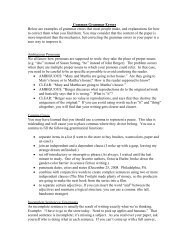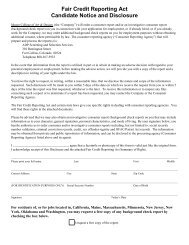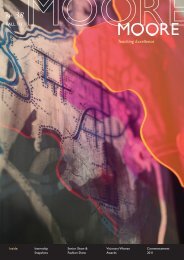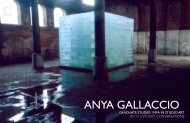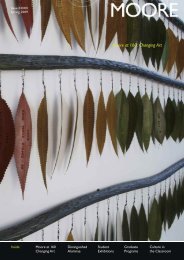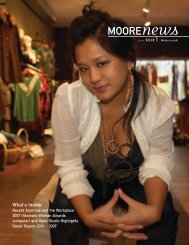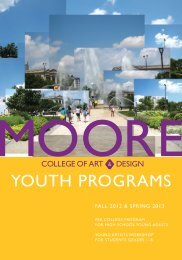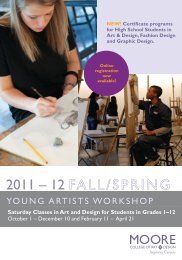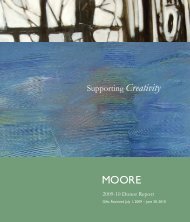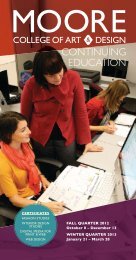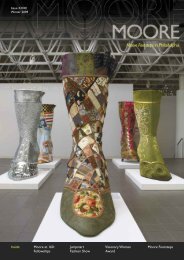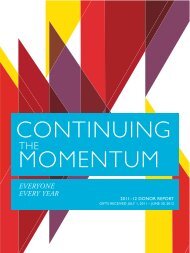2010 Graduate exhibition - Moore College of Art & Design
2010 Graduate exhibition - Moore College of Art & Design
2010 Graduate exhibition - Moore College of Art & Design
- No tags were found...
You also want an ePaper? Increase the reach of your titles
YUMPU automatically turns print PDFs into web optimized ePapers that Google loves.
Make Your MarkChange Your Life<strong>Graduate</strong> Studies at <strong>Moore</strong><strong>2010</strong> <strong>Graduate</strong> ExhibitionMA in <strong>Art</strong> Education With an Emphasis in Special PopulationsAugust 7 – September 4, <strong>2010</strong>Levy Gallery for the <strong>Art</strong>s in Philadelphia
<strong>Graduate</strong> Studies at <strong>Moore</strong>Happy Craven FernandezPresidentDona LantzAcademic Dean1<strong>Moore</strong> <strong>College</strong> <strong>of</strong> <strong>Art</strong> & <strong>Design</strong> proudly presents the inaugural class <strong>of</strong> <strong>2010</strong> Master <strong>of</strong> <strong>Art</strong>s graduatecandidates in <strong>Art</strong> Education with an Emphasis in Special Populations. This new MA in <strong>Art</strong> Education is one <strong>of</strong>three new co-educational low-residency graduate programs launched in Summer 2009 and is another “first”in <strong>Moore</strong>’s long and unique legacy in the field <strong>of</strong> <strong>Art</strong> Education. As early as 1862, the <strong>College</strong> <strong>of</strong>fered courses inteaching art and later adopting teacher education into the curriculum. In 1933, <strong>Moore</strong> became the first schoolauthorized by the Commonwealth <strong>of</strong> Pennsylvania to grant a Bachelor <strong>of</strong> Science in art education. Inaddition to this Masters, <strong>Moore</strong> now <strong>of</strong>fers a Bachelor <strong>of</strong> Fine <strong>Art</strong>s and a Post-baccalaureate certification in <strong>Art</strong>Education. The MA in <strong>Art</strong> Education is one <strong>of</strong> the three new graduate programs now being <strong>of</strong>fered at <strong>Moore</strong><strong>College</strong> <strong>of</strong> <strong>Art</strong> & <strong>Design</strong>. Next year we will celebrate the new graduates in Studio <strong>Art</strong> and in 2012, the first class <strong>of</strong>graduates in Interior <strong>Design</strong> in 2013. Reaching these milestones significantly demonstrates <strong>Moore</strong>’s ongoingcommitment to adapting to the needs <strong>of</strong> future generations <strong>of</strong> artists, designers, scholars and educatorsthrough diverse educational programs that prepare them for lifelong learning and leadership.The six graduate candidates featured in this <strong>exhibition</strong> catalog will forever hold the distinction <strong>of</strong> being thefirst class to enter into <strong>Moore</strong>’s unique Master <strong>of</strong> <strong>Art</strong>s program in <strong>Art</strong> Education with an Emphasis in SpecialPopulations and for being <strong>Moore</strong>’s first graduating class <strong>of</strong> masters students to defend a thesis and presenta thesis <strong>exhibition</strong>. This distinguished class <strong>of</strong> graduate candidates helped to shape <strong>Moore</strong>’s new graduateculture. They set a high bar <strong>of</strong> engagement and achievement that will inspire all future art graduate candidates.Like any other master’s level program in art education, <strong>Moore</strong>’s program had rigorous lecture and seminarbased course work, however, what makes this program unique is the extensive field research focused onstudents with disabilities. During field placement, each graduate candidate researched and then tested theirthesis question by working with students with disabilities in their K-12 art classroom and in the schoolcommunity. The graduate candidates gathered and analyzed data using a variety <strong>of</strong> methods includingobservation, interviews and surveys. The result <strong>of</strong> this research led to each graduate candidate developingan action plan that included a strategy for enhancing the learning <strong>of</strong> students with disabilities throughout thecurriculum. Credit goes to Lynne Horoschak, <strong>Graduate</strong> Program Manager in developing this outstanding program.It was Lynne’s passionate believe in the power <strong>of</strong> art education and how the use <strong>of</strong> art strengthens the learningenvironment for individuals with special needs that shaped this unique program, the only one <strong>of</strong> it’s kind inthe nation. <strong>Moore</strong>’s first thesis <strong>exhibition</strong> catalog establishes a precedent for the forthcoming graduates <strong>of</strong>the MFA program in Studio <strong>Art</strong> in 2011 and MFA program in Interior <strong>Design</strong> in 2012. Congratulations to<strong>Moore</strong>’s first <strong>2010</strong> graduating class <strong>of</strong> master’s candidates!
<strong>Graduate</strong> Studies at <strong>Moore</strong>MA in <strong>Art</strong> EducationIan VerstegenDirector <strong>of</strong> <strong>Graduate</strong> StudiesThe challenge <strong>of</strong> the thesis component for the MA in <strong>Art</strong> Education with an Emphasis in SpecialPopulations is to select a topic <strong>of</strong> importance to pedagogy and produce results that are immediatelyapplicable in the class room. As seasoned teachers, all <strong>of</strong> our students have no problem seeing challengesto current educational practice. The MA prepares them to frame this experience in a theoretical way anddesign strategies for assessment to judge whether their intervention is effective. The special students withwhom our MA candidates worked had a number <strong>of</strong> disabilities: Attention-Deficit/Hyperactivity Disorder(ADHD), Autism, Emotion and Behavioral Disturbance (EBD). The theses presented here and in the LevyGallery used the arts in two primary ways: first, as a means to maintain the attention <strong>of</strong> students withdisabilities and to improve learning in other subjects and, second, as a way to help themsuccessfully cope and be more engaged in the classroom. Thus, in the first sense, Patricia Hutman usedart as a means to teach English and Math subjects, Gloria Rautman used pop culture to help her studentswdevelop interest in their art projects, Bridget Glenn utilized art and music to address math problems, andAmy Cardullo employed active learning methods to teach literacy and artistic concepts. In the second sense,Alisha Hagelin studied the kind <strong>of</strong> art room environment that was best for engaging students with EBD andCynthia Hartopp introduced students with autism into the general student body where she gave allstudents the same assignments, finding that the students with autism both engaged with the art projectand interacted successfully with their peers. These projects have led to clear results, which will continueto be put into practice in our graduates’ classrooms and schools. Their hard work and commitment to theeducation <strong>of</strong> our children with disabilities is to be applauded.<strong>2010</strong> <strong>Graduate</strong>sAmy CardulloBRIDGET GLENNALISHA HAGELINCYNTHIA HARTOPPPATRICIA HUTMANGLORIA RAUTMANLYNNE HOROSCHAK<strong>Graduate</strong> Program ManagerMA in <strong>Art</strong> EducationMA in <strong>Art</strong> Education With an Emphasis in Special PopulationsThe MA in <strong>Art</strong> Education program with an emphasis in special populations prepares candidatesto critically assess and challenge existing art education policies and practices. Because <strong>of</strong> theprogram’s unique curriculum, candidates gain specific skills and resources to strengthen thelearning environment through the use <strong>of</strong> art for exceptional students including individuals withdisabilities, the gifted and the elderly. The program fosters research-based and experientialbased learning as candidates develop and test innovative and adaptive teaching strategies inpr<strong>of</strong>essional field settings.2 3
MA in <strong>Art</strong> EducationBridget GlennBFA <strong>Moore</strong> <strong>College</strong> <strong>of</strong> <strong>Art</strong> & <strong>Design</strong>Integrating the <strong>Art</strong>s into the Math CurriculumThe area <strong>of</strong> focus for this action research project was to use the arts to teachmathematics to students exhibiting attention-deficit/hyperactivity disorder (ADHD)behaviors. My research questions were:• Does adding art to a math lesson increase the percentage <strong>of</strong> on-task behaviors <strong>of</strong>students exhibiting ADHD characteristics?• What art strategies can be implemented in teaching mathematics for studentsexhibiting ADHD characteristics?• Will teaching mathematics through the arts to students exhibiting ADHDcharacteristics increase their achievement scores?<strong>Art</strong> and music was introduced into math lessons. I used surveys, interviews, andobservations as methods to collect the data for approximately eight weeks. Thefollowing month the data was analyzed. I found an improvement, especially toward the endwhen students Attention Deficit Hyperactivity Disorder (ADHD) characteristics weresubstantially more on-task. According to student achievement scores and studentenjoyment <strong>of</strong> the lesson, I found different art strategies could be implemented into themath lesson, however, using music with the students proved to have the best results.The student referenced pictures <strong>of</strong> shapes and recreated them as prints,using construction paper shapes painted with watered-down temperapaint on top <strong>of</strong> shaving cream.The student created a collage by drawing, cutting, labeling and gluingpolygons on black construction paper.6 7
MA in <strong>Art</strong> EducationAlisha HagelinBA Temple UniversityGraphite self-portrait and “soldier” by the same student.Complimentary color fashion design projectby another student.The relationship between the <strong>Art</strong> Room Environment and theBehavior <strong>of</strong> Students with Emotional Disturbance in an Inner-CityHigh School <strong>Art</strong> ClassImagine teaching students who have little control over their emotions. These students areat a high risk <strong>of</strong> dropping out, generally earning lower grades, failing more courses, andretained in grades more <strong>of</strong>ten. They will have more difficulty adjusting to adult lifethan students with other disabilities. These are students who live with Emotional andBehavioral Disturbance (EBD). My research study explores the factors that producesuccess in the art classroom. The qualitative study asked the questions, “What is the relationshipbetween the art room environment and student behavior?” and “How does the environment<strong>of</strong> the art room affect the way a student feels?” The eight-week study followed two studentsidentified with EBD and gathered data through student observations, student interviews,teacher surveys, and document analysis <strong>of</strong> the students’ artwork. The students had theopportunity to be self-reflective about their art room success. The data revealed that thestudents felt supported through a positive and accommodating work atmosphere, as theymade independent choices in assignments and materials and experienced an outlet for theiremotions through art. The action plan recommends that students with EBD receive as muchexposure to art as possible, both in school and at home.8 9
MA in <strong>Art</strong> EducationCynthia HartoppBFA <strong>Moore</strong> <strong>College</strong> <strong>of</strong> <strong>Art</strong> & <strong>Design</strong>Inclusion art class at East Stroudsburg’s North High SchoolStudents painting their plaster insects they sculptedDetermining if Inclusive <strong>Art</strong> Education Practices Improve thePerformance <strong>of</strong> Students with Autism through Two and ThreeDimensional <strong>Art</strong> Projects in a Diverse High SchoolThe number <strong>of</strong> children diagnosed with autism has been on a steady increase over the pastdecade; the effect is that there are more students with autism in schools than ever before.The goal <strong>of</strong> my three-month study was to create an inclusive art setting for students withautism to help them grow both academically and socially. In an urban high school, I becamethe first teacher in the District to take the students with autism out <strong>of</strong> their resourceroom and include them in class with regular students. The intention was to socialize thechildren with autism with the typical children while they were being taught the samecurriculum. I collected and recorded the data through lesson plans, observations, interviews, andassessments. In the beginning <strong>of</strong> my study, the students with autism and the regular educationstudents kept to themselves without much interaction. As the weeks progressed, thestudents with autism interacted socially with the regular education students and werelooking to them for guidance on their projects. The students became a family that pushedeach other to success. I found that the students with autism were not only learning howto interact with the regular education students, but they were, also, learning how tosuccessfully engage in an art project.10 11
MA in <strong>Art</strong> EducationPatricia HutmanBFA <strong>Moore</strong> <strong>College</strong> <strong>of</strong> <strong>Art</strong> & <strong>Design</strong>What Collaborative Strategies Can Be Used by the <strong>Art</strong> Teacher to EngageUrban Students with Special Needs?Working with urban youth who have special needs is a challenge. The purpose <strong>of</strong> thisstudy is to determine what collaborative strategies can be used by art teachers to engagestudents with special needs. This study helps us understand how urban students learn andStudents create the ro<strong>of</strong> for their circular tree house structure12how to enhance the curriculum to assist the students in achieving academic success. Throughart, students classified with attention-deficit/hyperactivity disorder (ADHD) have theopportunity for hands-on activities that are more physical, giving them the necessarymeans to relieve the anxiety <strong>of</strong> having to curb their actions.<strong>Art</strong> was used as a catalyst for understanding in other subjects. English and Math were the twosubjects chosen for the study. The English lesson in identifying repetition and alliteration inlyric poetry was accomplished through the active organization <strong>of</strong> the lines <strong>of</strong> a poem. Thelesson clearly engaged the students and aided in their understanding <strong>of</strong> the objectives <strong>of</strong>the lesson. In Math, the concept <strong>of</strong> scale was taught by using tree houses, which fascinatedthe students who are interested in aboriginal tribes’ use <strong>of</strong> tree houses and the fantasy <strong>of</strong>living in a tree. Students were fully engaged in building and constructing the tree housemodel. The collaboration between the art teacher and the classroom teacher engagedurban students with special needs, resulting in students spending more time on task,greater peer cooperation, and a genuine enthusiasm for learning. This study enhances thestandard curriculum by supporting students with special needs through art.13Students place lines <strong>of</strong> the poem “Life Doesn’t Frighten Me” inorder as they remember them
MA in <strong>Art</strong> EducationGloria RautmanBA Temple UniversityThe Effect <strong>of</strong> Integrating Pop Culture in Teaching Practices in InclusionGraphic <strong>Art</strong> ClassesTwo assignments where students translated images to which theyrelated into graph format in order to learn the concept <strong>of</strong> pixelsThe effect <strong>of</strong> popular culture on the behavior <strong>of</strong> people in developed societies hasescalated since the 1960s, when Andy Warhol already celebrated it through his art.The behavior <strong>of</strong> children, because <strong>of</strong> their impressionability, is most affected by mediaexposure to popular culture. An education system as large as that <strong>of</strong> the Americanpublic schools ought to develop media literacy programs to help children recognize andunderstand how media symbols and messages influence their behavior in regard toidentity development and consumption as consumers. Furthermore, tailoring this curriculumto help special education students with informed decision-making and occupational life skillsdevelopment will improve their real life judgment.I conducted this study to determine how integrating pop culture with teachingpractices increases the success <strong>of</strong> special needs students in inclusion classes. I used lessonsto teach the origin <strong>of</strong> visual images through technology. The results show that studentsworked well with the art and technology projects, giving them the freedom and ability tomake choices and work at their own pace, thus strengthening competencies inconfidence-building and independent learning.14 15
<strong>Graduate</strong> Studies at <strong>Moore</strong><strong>Graduate</strong> Studies at <strong>Moore</strong>Paul Hubbard<strong>Graduate</strong> Program ManagerMFA in Studio <strong>Art</strong>MFA in Studio <strong>Art</strong>The MFA in Studio <strong>Art</strong> program’s unique emphasis on international perspectives andMark Karlin<strong>Graduate</strong> Program ManagerMFA in Interior <strong>Design</strong>MFA in Interior <strong>Design</strong>The MFA in Interior <strong>Design</strong> is a first pr<strong>of</strong>essional masters degree that emphasizesrigorous, immersed study in fine art studio practice challenges the artist to confrontcritical thinking, skill development, advanced research and socially responsibletheir existing thoughts established practical and philosophical methods <strong>of</strong> working.design as a means to prepare individuals with undergraduate degrees in other fields toA required four-week international graduate residency in Burren, Ireland during thebecome pr<strong>of</strong>essional interior designers. Practical and the oretical work in studio andsecond summer term, as well as concept-based seminars and frequent interaction withtechnical classes include residential and commercial contractdesign,materialsandconstruction,nationally and internationally recognized faculty and visiting artists throughout themanualdrafting, CAD, history, environmental theory, design research and businessprogram, deepens the artist’s studio practice, strengthens and re-defines their work in newpractice. Studio seminars and critiques afford candidates multiple opportunities toand innovative ways and positions the artist and their work within a global arts environment.engage directly with experienced faculty and design experts in solving design issuesThe first class <strong>of</strong> graduates in this program will present their thesis <strong>exhibition</strong> inThe first class <strong>of</strong> graduates in this program will present their thesis <strong>exhibition</strong> inAugust 2012.August 2012.16 17
For more info on the <strong>Graduate</strong> Programs at <strong>Moore</strong>, contactgradstudies@moore.edu or the <strong>Graduate</strong> Admissions Coordinator at 215.965-.4016.Visit us at http://www.moore.edu/site/graduate_programs.© <strong>2010</strong> <strong>Moore</strong> <strong>College</strong> <strong>of</strong> <strong>Art</strong> & <strong>Design</strong>All Rights Reserved. No part <strong>of</strong> this publication may bereproduced or transmitted in any form or by any means, electronicor mechanical, including photocopy, recording or any otherinformation storage-and-retrieval system, without writtenpermission from <strong>Moore</strong> <strong>College</strong> <strong>of</strong> <strong>Art</strong> & <strong>Design</strong>.The Galleries at <strong>Moore</strong> <strong>College</strong> <strong>of</strong> <strong>Art</strong> & <strong>Design</strong>20th Street and The ParkwayPhiladelpiha, PA 19103-1179215.965.4027 / galleries@moore.eduwww.thegalleriesatmoore.orgGallery HoursMonday – Friday: 11 am – 7 pmSaturday: 11 am – 5 pmClosed Sundays and all academic and legal holidaysAdmission: FREE




